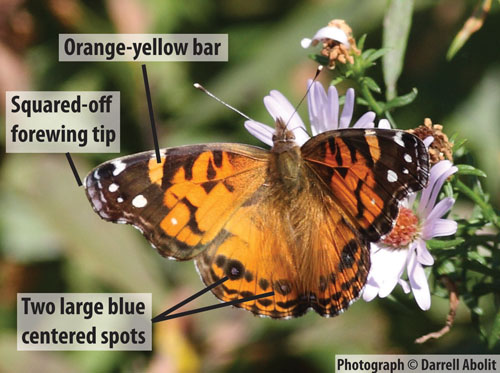American Lady (Vanessa virginiensis)
Description: A medium sized orange, brown, and black butterfly. The upperside of the forewing is orange basally and black with white spots toward the tip. The underside of the hindwing is orange with a subamarginal row of black spots - the lateral ones are larger and with blue centers. The underside of the forewing is pinkish-orange basally and brown and white apically, with several small eyespots near the tip. The underside of the hindwing is brown and white with two large eyespots. It is very similar to Painted Lady. See the Description of that species for distinguishing characters. Wingspan: 37 to 56 mm.
Maritime Distribution: Widespread throughout the Maritimes. For Atlas results click here.
Provincial Ranks: NB: S5B,S5M. NS: S5B. PEI: S4B.
Flight Period: Adults arrive in May and have been recorded into November.
Host Plant: A variety of plants in the aster family (Asteraceae), including Low Cudweed (Gnaphalium uliginosum), Pearly Everlasting (Anaphalis margaritacea), and various pussy-toes (Antennaria spp.).
Notes: Found visiting flowers in variety of open habitats, American Lady is a migrant that does not overwinter in the Maritimes. Once adults arrive in spring there are one to two domestic generations. Late fall specimens may be stunted or dwarfed because of a premature halt to their growing season. As with many migrants, their numbers fluctuate dramatically year to year. Southward migration is not well documented for this species but it and the other Vanessa species often gather in large numbers along the coast in fall. The larvae can easily be found by checking Pearly Everlasting plants for their tent-like webs.


